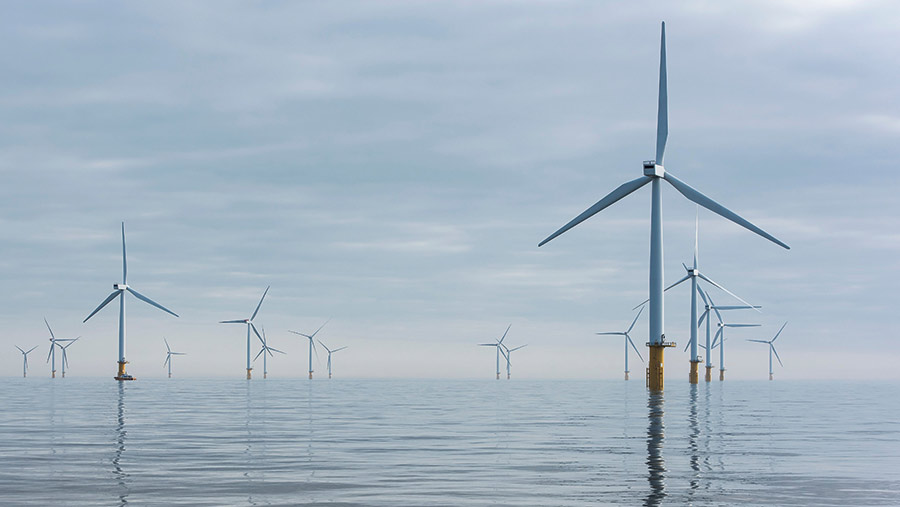Offshore wind expansion: What it means for farmers affected
 © Cultura/REX/Shutterstock
© Cultura/REX/Shutterstock A new generation of offshore wind farms is being planned and that means farmland will be needed for cables and sub stations.
But what does it practically mean for farmers on such a route and how can they safeguard their rights?
There are 30 offshore wind farms around the UK, with more than 5.1GW of operational capacity and a further 4.5GW already under construction.
But the government has identified 33GW of energy potential from offshore wind and eight zones are being actively developed around the east and south coasts to deliver this with a further one on the way.
Each zone will need cables and substations to connect it to the National Grid, involving years of planning, negotiations with landowners, construction and the reinstatement of land to what it was before.
Offshore wind projects in construction or planning
Hover on the icons on the map to see the offshore wind projects in construction or planning.
See where cables are planned on the Crown Estate website (PDF)
How much land will be needed for each cable corridor and substation will vary depending on the project (see more below), but informing yourself and getting involved with the planning process early will help minimise the short and long-term disruption to your business.
Jump to:
When to get involved
Depending on the size and complexity of the project, the planning and consultation process can take about two years, followed by another two to three years of construction.
There are six stages of the planning process an offshore wind farm developer must go through, but it is a very “front loaded” process, explains Fraser Paskell, senior solicitor at Churchgate Accountants.
This means key decisions are taken early on and options to a developer narrow later. The best time therefore to influence the project is at the beginning, with the “pre-application stage”.
This is when a developer is legally required to go out and consult with any person who has an interest in the land in question, including the local community.
“The key is making [representations] in writing, on an informed basis,” says Mr Paskell, which means understanding the project and the legal basis on which the developer can be challenged.
Landowners should consider what long-term plans they have for their business and think about how the cable route might impact this. For example, once a cable is in place a landowner would not be able to build on top of it as access for maintenance will be needed.
For example, once a cable is in place a landowner would not be able to build on top of it as access for maintenance will be needed.
“It is a mistake and a missed opportunity not to make a well-argued case at this stage, since the issues raised are to soften up the developer in case it is necessary to repeat these issues with the planning inspectorate, later at stage two,” explains Mr Paskell.
It is, however, not really feasible to challenge a nationally significant project such as an offshore wind farm on the basis that you don’t want, or agree with it, he says.
“For all intents and purposes, they’re going to get what they want, so it’s how you influence it.”
At the second stage – “pre-acceptance” the developer submits an application to the Planning Inspectorate (PI) with an Environmental Impact Assessment (EIA) report – these are published on www.gov.uk/government/organisations/planning-inspectorate after 28 days if accepted.
The EIA is the first opportunity for a landowner to see details of the project, such as area needed for cable corridors, and also what the developers plan to do to mitigate issues, such as noise pollution, waste, damage to soil and land, says Adrienne Copithorne, solicitor and partner at Richard Bush solicitors.
At the next point, “acceptance”, interested parties must register with the PI to become a formal consultee and guarantee their views are legally included in the process.
They must then submit their views at the next stage – “pre-examination” and submit full written or oral submissions at the “examination stage”, says Ms Copithorne.
Finally, there is a six-week window from the decision, the “post-decision period” where in theory it is possible to legally challenge what has been decided, however, the basis for challenge is very restricted, adds Mr Paskell.
The landowner should employ a lawyer, land agent, or other professionals who have experience of such projects – not just compulsory purchase – to make the best case, he advises.
The developer should pay the farmers’ reasonably incurred costs for professional advice, so ensure you maintain an accurate record of costs and also your time.
What impact does a cable route have on farmland?
See the diagram of the wind farm cable routes
The diagram is an example of a cross-section of land needed for the construction of a cable corridor and shows the different impact an AC and DC line can have on landowners.
The measurements are those proposed for the Norfolk Vanguard Offshore Wind Farm and so will vary depending on each development. Landowners should check a developer’s environmental impact assessment report for details of a particular project.
DC cables (top diagram) can transport more energy than AC cables (bottom), explains Bill Slegg, chartered engineer at Energy People, so fewer cables – and land – are needed for the corridor.
As well as needing to give up more land for an AC line, landowners along the route will have to deal with manhole covers every 1,000m or so, to cover “link boxes” – which are large concrete structures buried in the ground at about 1-2m deep.
By working with the contractor it is possible to have the manhole covers placed on banks or in hedges to minimise problems for farm machinery, says Mr Slegg, although doing this may mean more covers and boxes are needed.
An AC line will also need land for a booster/relay station and a station to connect to the grid. Mr Slegg estimates these would need between three and 10 acres in the Norfolk Vanguard case, but says they can be bigger.
A DC line, by contrast, does not need link boxes along the route, or a booster station.
Instead, it needs a larger “converter station” near the end of the line that could take up 20 acres, plus a substation to connect to the grid. It is, however, a more expensive option for the developer over a smaller distance.
As Mr Slegg explains, landowners in the middle of a route will be impacted more if it is an AC line, whereas those at either end of the cable should expect to have more land taken with a DC route.
Negotiating an option agreement
Often the best course of action for a landowner is to throw their hat in the ring and negotiate an option agreement, says Mr Paskell.
Fighting the route will likely be unsuccessful and doing nothing and just waiting for compensation will leave you with little to fall back on should construction issues arise.
An option agreement, allows you to negotiate a contract with the developer and include heads of terms on whatever might concern you about the impact on your life and business (see below for a checklist of key heads of terms).
It is also in the interest of the developer to negotiate option agreements rather than resort to compulsory purchase, as the Planning Inspectorate has sometimes turned away applications where not enough agreements have been negotiated, says Mr Paskell.
Time also costs developers money on these large projects – sometimes £1m/day even before construction – so they should be keen to reach agreement with landowners.
Option agreement checklist
The following points all need to be addressed in the option agreement, but the list is not exhaustive and professional advice should be sought.
 Jane Kenny, rural surveyor and associate director, Savills.
Jane Kenny, rural surveyor and associate director, Savills.
You should be looking for advice from professionals experienced with these specialist projects.
Parties
The option agreement should name the relevant parties – in this case it will be you as landowner and the developer.
Subject land
You will need to state the address and attach accurate plans so the area affected is clearly defined Before reaching this stage you should have looked into limiting the extent of the land being offered so as not to sterilise too much of the farm.
 Fraser Paskell, senior solicitor, Churchgate Accountants
Fraser Paskell, senior solicitor, Churchgate Accountants
Consideration payment
How much will you receive from the developer?
Once a figure has been agreed, the owner will receive a percentage of the sum on signing the agreement and the balance when the option is exercised.
Professional advisers will be able to identify comparable evidence and so achieve the best price.
Point of contact
Effective communication is vital so agree a single point of contact, allowing you to keep in the loop at all times; you will want a person and number to call in case there is an emergency.
Access
How will the contractors gain access to the land from the highway and do time restrictions need to be put in place? These must be agreed and set out, otherwise, they may take shortcuts and cause more damage than necessary. This is a problem especially if there are many contractors.
Drainage
What are the arrangements for drainage and how will they be affected by the works? You should be looking to the developer to instruct your existing drainage consultant to ensure continuity.
Depth of cables and location of cross bonding pits
This kind of practical detail needs to be identified from the outset and incorporated into the option to minimise the impact of the scheme; if cables are too shallow it may make the land unsafe for normal farming operations. You will want to aim for not less than 1m.
Crop compensation
The actual figure will be worked out at a later date but you need to make sure you agree that compensation for loss of income will be paid.
You also need to include provision for future crop loss as the full impact may not be immediately apparent.
Also the scheme will be sold to a new owner, so you need to ensure they take over responsibility for these payments.
Repair obligations
It is possible the scheme won’t only affect the land in question but also other land in your ownership such as farm tracks. Constant vehicle use could cause damage so it is important to agree who will be responsible for funding
Constant vehicle use could cause damage so it is important to agree who will be responsible for funding these kind of repairs.
You should insist on a record of condition of any likely affected tracks to save arguments later.
Reinstatement of land
How and when will this be done?
A key point to include is the land is reinstated in the correct weather conditions to prevent future problems such as compaction, drainage issues and loss or damage of top soil.
You should also check the soil management plan, to ensure common sense rules such as not spraying off weeds in windy conditions.
BPS and other schemes
The agreement will need to cover loss of BPS payments (or the successor post Brexit) and appropriate derogations for any agri-environmental schemes on the holding.
Biosecurity
There will be biosecurity matters that will need to be considered on certain holdings due to livestock, especially pigs and poultry, or if the land has organic status; again you may want a baseline record of condition.
Professional fees
Your agreement should state all reasonable professional fees, such as for solicitors and surveyors, will be met by the developer.
Bespoke provision
Different landowners will have different requirements. It may be you will require access for sporting pursuits or irrigation.
These bespoke provisions need to be agreed.
Negotiating access
Access agreements should be negotiated so every party knows what is allowed to happen on the land.
Non-intrusive access arrangements allow someone such as a surveyor to enter a farmer’s land to do such things as an environmental survey when planning a route.
Intrusive access agreements then allow developers to carry out things such as soil structure assessments, by sinking trial boreholes.
The agreement should include provisions to ensure the contractor gives the landowner sufficient notice that they will be arriving and should detail where they can park so they do not get in the way of farm operations, advises Jane Kenny, rural surveyor and associate director at Savills.
Landowners should make sure the contractor has the correct level of indemnity insurance should anything happen and they have conducted risk assessments for any lone workers they send out, she says.
Biosecurity should also be considered, especially for pig and poultry units and restrictions applied.
It is also a good idea to require the developer or contractor to share the information they find collect about the farmland, as this may be useful in the future, says Ms Kenny.
Landowners should be aware that once construction has finished, the developer will normally sell the access right along the side of the route to an investment company.
This third party will have to take on all the obligations of the access agreement that has already been agreed.

